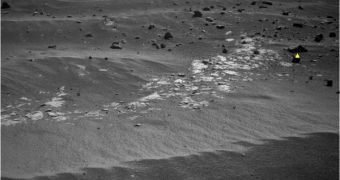The rover Opportunity, while somewhat shadowed by all the attention and coverage its twin Spirit gets, is undoubtedly an impressive scientific instrument. Currently in its seventh year on the Red Planet, it is becoming increasingly intelligent as the seasons pass, as experts managing it continuously try out new technologies on it. It's safe to say that in a few decades, when robotic space exploration is the norm, people will look back at Spirit and Opportunity and say that it was these robots that laid the foundation of it all. Just this winter, Opportunity was endowed with a new program to make it more independent.
The piece of software was uploaded in the robot's computers with the express goal of making it more autonomous, in the sense that mission managers want the rover to be capable of making its own decisions about the targets of its observations. Even now, the machine is able to analyze images it collects with its wide-angle cameras, and analyze them with its computers. If it discovers rocks that meet certain criteria (roundness, coloring), it can then decide to stop, and move in for a closer look.
This is especially useful because generally it takes a few days for experts at the NASA Jet Propulsion Laboratory (JPL), in Pasadena, California, who manage the MER mission, to identify targets of interest. In the mean time, Opportunity travels a considerable distance, and it needs to backtrack so as to investigate a target further. An added advantage is the fact that experts get a chance to test new autonomy technologies, which will undoubtedly make their way on any new robots that are constructed for exploring other planets, asteroids, and so on.
When the new software identifies targets of interest, it centers the rover's narrow-angle cameras on that particular rock, and then snaps a series of pictures, using various color filters. “It's a way to get some bonus science,” explains JPL rover driver Tara Estlin. She is also a senior member of the JPL Artificial Intelligence Group and the leader of development for this new software system, called Autonomous Exploration for Gathering Increased Science, or AEGIS. “We spent years developing this capability on research rovers in the Mars Yard here at JPL. Six years ago, we never expected that we would get a chance to use it on Opportunity,” she adds.

 14 DAY TRIAL //
14 DAY TRIAL //